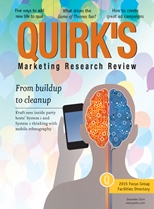Marketing research and insights news and information. This issue's keywords: Hispanic-Americans; social media; advertising campaigns; mobile
A study of Hispanic-American families found that they watch television as a family more than Caucasian families (45 percent and 32 percent respectively) and that more than 60 percent of Hispanic parents believe that “TV helps me be a better parent,” compared with 50 percent of Caucasian parents. Hispanic parents also agree that TV helps keep kids out of trouble (27 percent) compared with 22 percent of Caucasian parents. The study was conducted in May 2014 by Washington D.C. researcher Penn Schoen Berland on behalf of the Association of National Advertisers, New York, and its Alliance for Family Entertainment division and included 222 English-speaking Hispanic-American parents and caregivers.
A study by Influence Central, a Newton, Mass., marketing firm, and Vibrant Nation, a Louisville, Ky., online publisher, found that women over the age of 45 without minor children at home are involved in social media and utilize technology, including mobile, when researching and making purchases. The survey of over 600 U.S. women over the age of 45 without minor children at home, was designed to examine their purchasing decisions, found common misconceptions in advertising and marketing to this group of women, called Empty-Nesters in the study. Rather than using traditional advertising as marketers may assume, the Empty-Nesters reported using online reviews and blogs in making purchase decisions.
Videology, a New York-based marketing and advertising firm, issued its Third Quarter UK Video Market At-A-Glance, showing that the number of advertising campaigns running together on PC, mobile and connected TV devices increased from 25 percent in Q1 to 53 percent in Q3. In addition, campaigns running together on PC and mobile jumped from 5 percent to 12 percent during the same time period. The report also showed that 95 percent of the video campaigns were bought on a guaranteed fashion rather than RTB and 69 percent of all ads in Q3 were 30 second spots which was a 15 percent increase from the same time period in 2013.
A new report shows that although 17.9 percent of social network users share video, a “super sharers” group is responsible for 82.4 percent of all video shares. The study by The Geography of Sharing, London marketing firm Unruly reports that Facebook has the majority of these videos, with 59.4 percent, with smaller portions on Twitter (13.8 percent), Google+ (9.3 percent), Tumblr (5.7 percent) and Pinterest (3.9 percent).
A study by San Fransisco marketing firm AppLovin reported that women click on mobile ads more than men, show better conversion rates and spend more per purchase. The study shows differences in mobile behavior between men and women and by platform. Android users were found to click on more ads than iOS users, but iOS users convert more often and spend more. The biggest spenders overall were women on iOS devices. Demographic data from the study showed that iOS users tend to be more affluent than Android users, who represent a broader cross-section of the population. The study was compiled from “over a billion” data-points from July, 2014.
These reports were compiled from recent issues of the Daily News Queue, a free e-newsletter digest of marketing research and insights news and information delivered each business morning. Not already in the Queue? Sign up here!
